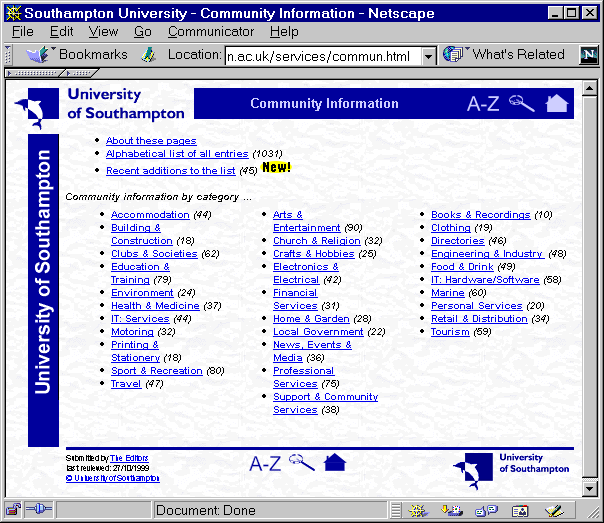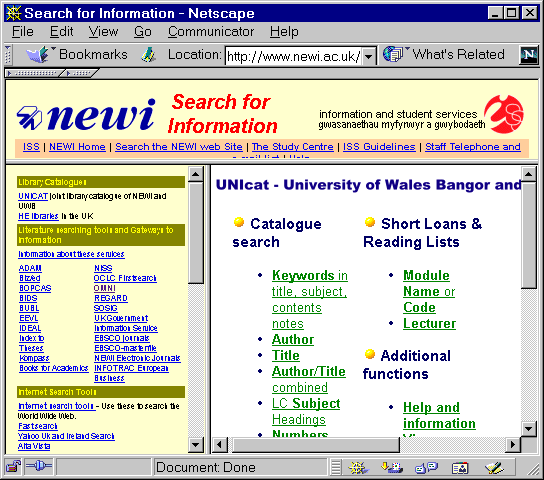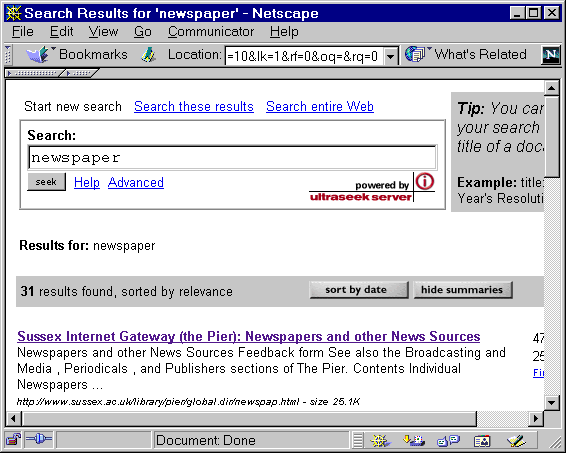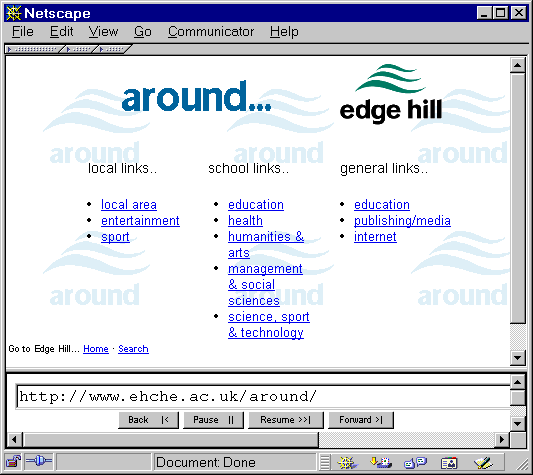Web Watch: A Survey of Institutional Web Gateways
In September 1999 the author ran a 90 minutes hands-on session on Managing Your Institutional Web Gateway [1] at the JANET User Support Workshop which was held at the University of Plymouth. The materials for included a series of exercises in which the participants were asked to go to their own institutional home page, find the main page which contains links to external web resources and comment on the resource. After reviewing their own web site, they were then asked to look at a number of other university web sites and repeat the exercise. The feedback from the participants was very interesting. A number of people commented that they would have to address some of the deficiencies on their web site when they returned to their office. It was clear from the feedback from the session that participants were interested in obtaining further information on approaches to the provision of gateways to web resources within the community and to have the opportunity to discuss the issues associated with the provision of a quality gateway.
This article aims to give a preliminary assessment of gateways to external web resources provided in the UK higher education community. Comments on a number of interesting approaches are provided. The article concludes by discussing some of the issues which emerge from the survey.
The Survey
On 18th October 1999 a message was sent to the website-info-mgt Mailbase list asking for the URL of institutional "web gateways" [2]. A small number of replies were received, but not enought to provide the location of significant numbers of web gateways. As a result a manual search of web gateways was carried out, using the list of UK University and Collages entry points maintained by HESA [3]. This was followed by a request for information which was sent to the webmaster email address.
This survey was more difficult to carry out that the surveys of UK University 404 pages [4] and institutional search engines [5]. The 404 error messages were very easy to find and institutional search engines were often located on and linked from the main entry point. Institutional gateways to external web resources typically could not be found on the main entry point. It required the time-consuming process of following likely links, often under areas maintained by the institional Web Team or the responsibility of the Library, Information Services or Learning Centre.
As a result of the difficulties in finding the institutional web gateways this article provides only a incomplete study. The author invites readers to provide details of their institutional web gateways which will be used in a follow-up report.
Details of the institutional web gateways to external resources found in the survey are available [6].
Interesting Examples From UK Universities
The Users' View
The University of Southampton provides a well-designed gateway to web resources [7] which is reminiscent of the early days of Yahoo!, as can be seen from Figure 1.

Figure 1: University of Southampton Gateway
As well as grouping resources under a number of categories (over 30) a complete alphabetic listing is available, together with details of newly-added resources. Over 1,000 resources are available.
The gateway provides information about the community pages which states that "The pages consist of links to other sites which may be useful to the staff and students of the University and focus on services and resources geographically based in the area around Southampton - but a number of county based links are also included as are a selection of national information services which are thought to have a useful "local component" [8].
An interesting approach to the user interface was provided at Oxford University. OLIG (Oxford University Library Gateway) [9] uses a frames-based interface to resources, which are grouped under a number of subject areas (sciences, social sciences and Humanities). The frames interface also provides access to a small number of search engines and library catalogue interfaces.

Figure 2: OLIG (Oxford University Library Gateway)
An impressive interface (especially if your screen display matches the output) is provided by the Library at the University of Warwick [10].

Figure 3: Links to Electronic Resource at the University of Warwick
As can be seen from Figure 3 the gateway, which has the title Electronic Resources, provides access to (electronic) journals, databases (available on CD-ROM or on the web), newspapers (available on the web), library catalogues and general references resources available on the web.
The gateway provided by the North East Wales Institute of Higher Education [11] uses a frames interface to provide an integrated user interface to external web resources and internal library catalogues.

Figure 4: 'Search For Information' at NEWI
Behind The Scenes
A small number of institutions appeared to make use of back-end link management systems. The universities of Leeds [12] and Cranfield [13] use the ROADS software [14]. This enables the institutions to provide a searchable index as well as a browsable list of resources, as illustrated below.

Figure 5: 'Search for Selected Web Sites' at the University of Leeds
The University of Sunderland's gateway [15] also makes use of a back-end database to manage the link records.

Figure 6: 'Web Links' at the University of Sunderland
This gateway makes use of a Microsoft database.
The University of Sussex's PIER gateway [16] uses the Ultraseek indexing tool to provide searching of the catalogue records as illustrated below.

Figure 7: Using Ultraseek to Search the PIER Gateway
A Tour Of Web Gateways
A "web tour" of the gateways found in the survey has been produced [17]. As illustrated in Figure 8 the web tour provides a running display of the gateways, with each gatways being displayed for a few seconds.

Figure 8: A Tour Of Web Gateways
It is intended that this tour will provide an useful way of comparing the various approaches taken within the community.
Issues
A number of email replies to requests for information appear to indicate recognition that the gateways provided by UK Universities are less than ideal. Some of the comments received are listed below.
- "We don't really have [a gateway] really. I suppose the nearest thing is a page done a few years ago, but it isn't maintained and I know several of the links no longer work. ... The library have a page linked from their own site which is more useful."
- "[Our] "home pages", which are maintained by our Publicity and Marketing department, do not appear to include a list of external links. An old list, which dates back to the time when Computing Services maintained the "home pages", is still online ... but has not been updated for a considerable time."
- "I'm afraid we haven't been maintaining [the web gateway] page. Our out of of date and feeble effort can be seen at : [URL deleted] No one has touched it since May! Shame on us!"
Management
The survey confirmed the sentiments expressed in the first two quotes: the responsibilities for managing the gateway are not always clearly defined. In a number of institutions a number of central gateways may be maintained, perhaps by the computing services or the institutional web team and also by the library. As indicated in the second quote, publicity and marketing departments may not give a high priority to the provision of gateways to external resources.
QA and Scoping Policies
Related to management issues are the need for quality assurance and scoping policies. Cranfield's CRUISE gateway includes a link to its scoping policy [18]. This scoping policy is based on the one developed by OMNI [19]. The eLib subject gateways (which have recently evaolved into RDN hubs) have taken a leading role in the development of scoping policies and associated quality association procedures. A valuable reference, based partly on the experiences of the eLib subject is the Information Gateways Handbook, which has been published by the DESIRE project [20].
Link Management Software
What link management Software should be used to manage a gateway? It is becoming increasingly clear that simply creating links in HTML pages is no longer a satisfactory solution for a quality gateway. Storing links and catalogue records in HTML pages makes it difficult to re-use the information in other applications, manage the links or provide rich functionality to the end user (e.g. sort the display links in say, title order, order of destination, etc.)
A number of institutions make use of the ROADS software (a list is maintained by ILRT [21]). As mentioned above the University of Sunderland and Kingston Public Library use a Microsoft database solution for managing the links. Kingston Public Library illustrate how use of a backend database makes it possible to implement a value-added service, such as a Top 10 list [22].
Institutions could choose to make use of an open source solution, such as ROADS, or develop their own system based on a relational database. Examples of institutions which make use of these two approaches have been described in this article. A third approach would be to purchase a link management system.
LinkBank [23] is an example of a web-based link management system (note the LinkBank.net web site should not be confused with LinkBank.com which provides a Java-based bookmark manager).
LinkBank is a "programming-free way to add a searchable directory of links" to a Web site. Features it provides include daily link-checking, search facility, slideshows, email notification of changes and the ability to display links based on popularity, date and rating. Administrative facilities include bulk upload of links and provision of statistics.
An example of services which make use of LinkBank are available on their web site [24]. An additional example, from the UK HE community [25] is shown below.

Figure 9: LinkBank
As an evaluation of LinkBank the links to UK HE institutional web gateways and UK HE search engines which featured in this article and the previous WebWatch column are being added to a LinkBank page [26].
Other example of link management systems include HyperSeek [27], Links by Gossamer Threads [28], Plumtree's Corporate Portal software [29] and Inktomi's Directory Engine [30].
Other Technical Issues
If institutions choose to make use of link management software a decision they will have to make is whether to opt for a shrink-wrapped solution, open source software or a home-grown solution. The shrink-wrapped solution may have the least requirements for local technical expertise, but will have a capital cost and may make it difficult to implement local enhancements. Open source software such as ROADS, together the IMESH initiative [31] should provide a solution, based on open standards, which is extensible. However there is likely to be additional demands for technical expertise.
Conclusions
This article has described a survey of institutional gateways to external web resources, and has outlined a number of issues. One issue which has not been addressed is whether institutions should even consider using their scarce resources to provide such gateways. Since JISC, through the RDN [32], provides funding for a number of subject gateways, is it desirable for institutions to duplicate work which is already being done? Should institutions, instead, aim to complement the work which is being done nationally by, say, providing links to local resources - an approach taken at Exeter [33], University of London [34] and UWIC [35]?
If you do decide that you wish to provide your own comprehensive gateway to web resources it seems clear from this survey that the gateway will have to be adequately resourced, with scoping and QA procedures defined. The question of the software (and model) used to provide the gateway is an interesting one. The website-info-mgt Mailbase list [35] is a useful forum for discussing such issues. The author looks forward to an interesting discussion on this list.
References
- Managing Your Institutional Web Gateway, Brian Kelly
http://www.ukoln.ac.uk/web-focus/events/workshops/jusw-sep1999/workshop/ - Survey of institutional web gateways, Posting to website-info-mgt Mailbase List,
http://www.mailbase.ac.uk/lists/website-info-mgt/1999-10/0009.html - Higher Education Universities and Colleges, HESA
http://www.hesa.ac.uk/links/He_inst.htm - WebWatch: UK University Search Engines, Ariadne issue 21
http://www.ariadne.ac.uk/issue21/webwatch/ - WebWatch: 404s - What's Missing?, Ariadne issue 20
http://www.ariadne.ac.uk/issue20/404/ - Survey Of UK HE Institutional Web Gateways - Autumn 1999, UKOLN
http://www.ukoln.ac.uk/web-focus/surveys/uk-he-gateways-dec-99/ - Southampton University - Community Information, University of Southampton
http://www.soton.ac.uk/services/commun.html - About the Community Pages, University of Southampton
http://www.soton.ac.uk/services/local/about.html - Oxford Libraries Internet Gateway, University of Oxford
http://www.bodley.ox.ac.uk/olig/ - Electronic Resources, University of Warwock Library
http://www.warwick.ac.uk/services/library/electronicr/electronicr.html - Search for Information, NEWI
http://www.newi.ac.uk/iss/search/search.htm - Selected Web Sites, University of Leeds
http://www.leeds.ac.uk/ROADS/web.htm - CRUISE (Cranfield University Internet Site Explorer), University of Cranfield
http://www.cranfield.ac.uk/cils/library/subjects/webinfo.htm - ROADS: Resource Organisation And Discovery in Subject-based Services, ILRT, University of Bristol
http://www.ilrt.bristol.ac.uk/roads/ - Information Services Home Page, University of Sunderland
http://www.library.sunderland.ac.uk/default.asp - Sussex Internet Gateway: The Pier, University of Sussex
http://www.sussex.ac.uk/library/pier/ - Web Tour, UKOLN
http://www.ukoln.ac.uk/web-focus/surveys/uk-he-gateways-dec-99/web-tour/ - Collection development policy for Internet resource selection, University of Cranfield
http://www.cranfield.ac.uk/cils/library/subjects/colldev.htm - OMNI Guidelines for Resource Evaluation,
http://www.omni.ac.uk/agec/evalguid.html - Information Gateways Handbook, DESIRE
http://www.desire.org/handbook/ - Services Using ROADS, ILRT, University of Bristol
http://www.ilrt.bris.ac.uk/roads/who/ - Top 10, Kingston Public Library
http://www.kingston.gov.uk/libs/ref/topsites.asp - LinkBank, LinkBank
http://www.linkbank.net/ - Full Working Demo, LinkBank
http://www.linkbank.net/examples.html - Institute of Education, University of Sussex, LinkBank
http://www.linkbank.net/get_links/default/usie/ - WebWatch, UKOLN, LinkBank
http://www.linkbank.net/get_links/default/ariadne/ - The Hyperseek Search Engine, Hyperseek
http://www.hyperseek.com/ - Links, Gossamer Threads
http://www.gossamer-threads.com/scripts/links/ - Plumtree Software - Products, Plumtree
http://www.plumtree.com/products.html - Inktomi Directory Engine, Inktomi
http://www.inktomi.com/products/portal/directory/ - The IMESH Toolkit, IMESH
http://www.imesh.org/toolkit/ - RDN (Resource Discovery Network), RDN
http://www.rdn.ac.uk/ - The South West, University of Exeter
http://www.ex.ac.uk/thesw.htm - London Links, University of London
http://www.lon.ac.uk/london.htm - Local Links, University of Wales Institute, Cardiff (UWIC)
http://www.uwic.ac.uk/local_links.htm - website-info-mgt, Mailbase
http://www.mailbase.ac.uk/lists/website-info-mgt/
Author Details
 Brian Kelly
Brian Kelly
UK Web Focus
UKOLN
University of Bath
Bath
BA2 7AY
Email: b.kelly@ukoln.ac.uk
Brian Kelly is UK Web Focus. He works for UKOLN, which is based at the University of Bath
